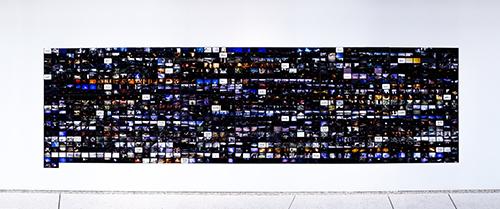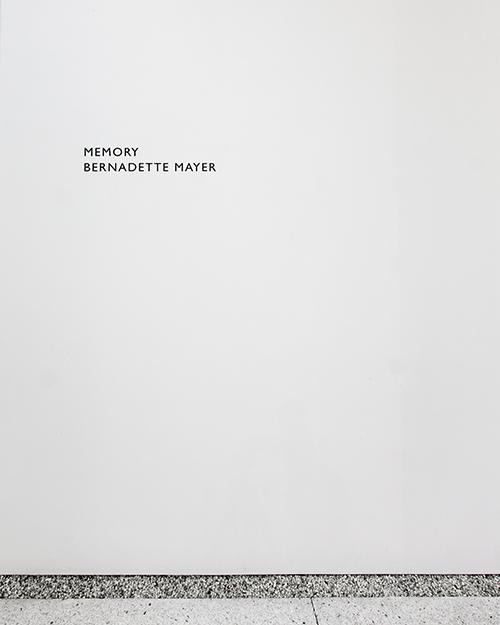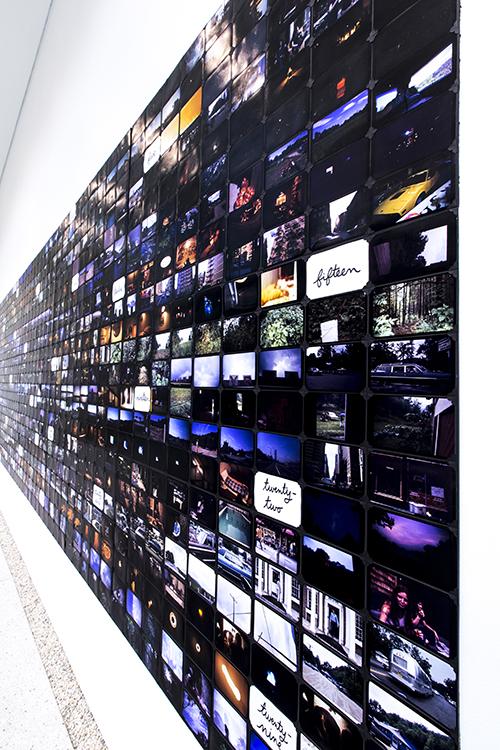Bernadette Mayer's 'Memory'

Bernadette Mayer’s Memory closes Wednesday, April 27 to make way for Vintage Poetry Center Posters from the University of Arizona Poetry Center. The show’s closing comes with much activity across town. Mayer will be in Chicago for a number of events, including a midday artist’s talk with Jennifer Karmin and Stephanie Anderson at the Poetry Foundation this Thursday at 12:00pm. To help keep it all straight, Anderson has put together a map of events, connecting Mayer’s activity while she’s here. Following that is an essay from writer and scholar Lucy Biederman on the various forms of Memory and Mayer’s “Disputed Territory.”
—Fred Sasaki

Sometimes I like to compare Bernadette Mayer to Madonna. Of course, an obvious difference lies in Mayer’s oft-quoted advice to her students: “Work your ass off to change the language and don’t ever get famous.” But over the course of her 50+ year career, Mayer has, like Madonna, resisted pursuing the same project twice. From her work as an editor and publisher to her experiments with form and lyric, Mayer has constantly queried and expanded our notions of what poetry—and indeed, language—can be. Chicago and Milwaukee are fortunate to host her this month, in a series of events that will showcase some of the variety and depth of her astonishing oeuvre.
On Wednesday, April 20, Mayer will read from recent work at the University of Chicago’s Regenstein Library at 6 pm (the Facebook event link can be found here). The next day at noon, in conjunction with the MEMORY exhibition at the Poetry Foundation, Mayer will have a public conversation with Jennifer Karmin and Stephanie Anderson about the installation. On Friday, you can look forward to a celebration of Mayer and Karmin’s collaborative chapbook, The Sexual Organs of the IRS & Other Poems, from Convulsive Editions, with readings by Mayer, Karmin, and Philip Good, at Sector 2337 at 7 pm in Logan Square (the Facebook event link can be found here). And if you’re in Milwaukee, you can catch Mayer, Karmin, and Good at the chapbook’s reading and release at Woodland Pattern on Saturday at 7 pm.
All these events are made possible by the generous support of the Poetry Foundation, University of Chicago’s Regenstein Library and Creative Writing Program, the Mandeville Special Collections Library at UC San Diego, Convulsive Editions, Sector 2337, and Woodland Pattern.
—Stephanie Anderson

A Memory of the Future: On Bernadette Mayer’s Memory
Bernadette Mayer is avant-garde in the true sense of the term: For more than forty years, she has been ahead of the pack. Mayer was tweeting what she had for lunch before Twitter existed: “i ate macaroni and cheese / like a good american.” She leaps among genres, forms, and media, without bothering to name them. She instigated frequent, often daily, collaborations with other writers and artists, before collaboration was cool.
Nowhere is Mayer’s avant garde sensibility more evident than in Memory, which is currently being exhibited at the Poetry Foundation in all its multimedia splendor for the first time since 1972. Memory is surprising for its up-to-the-instant relevance, even—or maybe particularly—among we who are accustomed to constantly hitting the refresh button. A cross-genre project that has been previously published in various formats, Memory is also indicative of why Mayer’s work is so difficult to categorize. Conceived as a performance piece for which Mayer attempted to record, via photographs, notes, and audiotapes, everything she experienced during July 1971, Memory was first presented as an installation in a Manhattan gallery in 1972, then published in book form in 1975 by North Atlantic Books. More recently, a digital version of the book has been made available at the University of Utah’s Eclipse archive, which presents digital versions of experimental books—“the most radical small-press writing from the last quarter century.”
The book of Memory includes text that Mayer produced for the project, but, aside from a few photographs reproduced on the book’s front and back cover, contains no other media. As Memory has moved from a gallery exhibit, to a book, to an e-book, the written aspects of Memory have been highlighted, while its visual and spatial aspects have been de-emphasized. This movement seems to coincide with Mayer’s own movement, across her career, away from conceptual art and toward conceptual writing. But Mayer is as much a performer—conceptually driven—as she is a writer. Memory, The Desire of Mothers to Please Others in Letters (1994), and Midwinter Day (1982) are performances in addition to written works, textual data gleaned from experiments. However, as Mayer has written and published pieces that look and read more or less like poetry books, her origins in performance and conceptual art, and the origins of Memory as a conceptual art piece, start to feel less important.
Until now. The 1972 gallery presentation of Memory has carried with it a bit of a you had to be there aura buzzing around it. When Memory was published as a book, in addition to losing most of the photographs and all of the sound-recordings present at the original gallery show, it also lost something nearly ineffable, but important—a space shared by its viewers/readers/listeners, the sense that they were all in it, figuring it out, together. The art scholar Liz Kotz writes of the 1972 gallery presentation of Memory that “its authorship is distributed among various functions that don’t necessarily cohere into a single self.”
Ironically, the Internet has allowed for easy access to Memory. Anyone can see and read the piece, for free, via the Eclipse archive—however, in the easily disseminated Eclipse edition of Memory, some of the qualities that make the piece so relevant to conversations about authorship and selfhood in the Internet age are scrubbed away. As a digital book, Memory seems nearly too coherent to make sense.
What makes Memory so different as a gallery presentation? The multimedia exhibition of Memory, with its sound, image, and text, is “a collective reenactment” of the past, according to the literary scholar Ann Vickery. Mayer’s individual past is recovered—collected, across formats—by everyone and anyone in attendance. That push and pull between public and private experience, between individual and group re-creations of the past, makes me think of Facebook. There, one’s experience is shown to have meaning when it is recognized by members of the collective, one’s friends.
Maybe Facebook has made conceptual artists of us all—or maybe Mayer arrived here, in 2016, back in 1971. In an interview included in Mayer’s 2011 The Ethics of Sleep (Trembling Pillow Press), Dave Brinks tells Mayer that even the earliest pieces, decades old, “read and feel as though they might’ve been written last month.” “What are you saying,” Mayer responds, “that I have a memory of the future?”

Mayer has referred to Memory an “emotional science project,” a phrase that makes me think simultaneously of high art and high school. In fact, Mayer has often used the discourse of science to talk about creative writing. Her extremely helpful and practically endless list of writing ideas, which is like a poem itself, is titled “Experiments.” “Attempt as a writer to win the Nobel Prize in Science by finding out how thought becomes language, or does not,” Mayer suggests.
Memory was also, Mayer says, an “unrepeatable work.” Even I, who cheated in high school chemistry but failed anyway, know that scientific experiments are, by definition, repeatable. So what is this pseudo-science Mayer is performing? Mayer draws on scientific imagery within the text of Memory when speaking about the methods of its composition: “i’m working more the way strudents in science are working in a lab,” she writes in an entry dated July 3. That misspelling of “students” stands as proof of the text’s automatic-writing-style construction. Moments of what could be called “human error” throughout Memory are reminders of Mayer’s “science.” Rather than self-correcting, she lets the record, and the moment, stand.
The appearance of Memory in a variety of published forms over the years—gallery, book, online, gallery again—lends some irony to Mayer’s description of the project as “unrepeatable.” However, this irony is embedded in the text as well, as Mayer implies that even as she was living these experiences, they felt doubled, replayed. Memory’s entry for July 20 begins, “Double exposures, live memory.” Again, Mayer’s words bring to my mind our current social media world, in which, as experience is recorded “live,” it doubles, cleaving into lived experience and projected memory. The phrase “double exposure” evokes the photographic element of Memory, as well as suggesting Mayer’s vulnerability in this personally revealing project—all the more vulnerable because at the time she was the only one doing it.
“I was never trying to take beautiful photographs. I was trying to take as many as possible,” Mayer says of Memory. Her tactics seem to directly anticipate what many of us do every day in the age of social media, recording everything we experience. Those intentions are simultaneously personally and publically archival, like the “personal history reminder” Facebook app On This Day that tells you—and your followers, of course—what you were doing at this time last year.
Memory isn’t the only one of Mayer’s works that speaks strongly to our current moment, which, for all we know, might come to be thought of as suffused with an Internet haze in the way that the 1950s now seem blurry with cigarette smoke. However, despite the ultra-relevance of her work, Mayer does not have the broad cultural cachet that, for example, Gertrude Stein—one of Mayer’s influences—retained throughout her life.
Perhaps Mayer’s relative lack of notoriety is due to her nearly career-long adherence to ambiguity. It is not just Mayer’s work that is difficult to classify, but Mayer herself. A 2011 Poetry Foundation interview begins with Mayer being asked a simple question—whether she was born in Brooklyn or Queens—to which she responds with a confusing (but charming) neither/both answer: “The Disputed Territory,” she says, “Brooklyn/Queens, New York,” adding, “I’m honored to be part of the Disputed Territory.”
Maybe hailing from the Disputed Territory has influenced Mayer’s disregard for poetic allegiances and groupings. In anthologies and scholarly studies, Mayer is sometimes called a New York School poet, sometimes a Language poet, sometimes a conceptual writer. Asked to clarify the situation, Mayer herself is of no help whatsoever. Of language poetry, she says, in that same interview, “I like it now that they—I shouldn’t say ‘they’—that they’ve developed a sense of humor. For a long time it was in abeyance; now it’s back—well, I don’t think it ever existed, but now it does.” Mayer’s statement is characteristically sphinxlike, full of strong proclamations that she then half-retracts. Her self-admonishing “I shouldn’t say ‘they’” is followed almost immediately—and humorously—by another “they.” Even if Mayer had not begun the interview by saying she was from the Disputed Territory, we would probably be able to tell anyway, by how fluently she evades avoids precision.
Mayer’s “disputed” status extends to the unstable space she occupies between poet and performance artist. Her 1982 book Midwinter Day is another example of why she is so difficult to categorize. The conceit behind the book is that Mayer wrote it entirely on December 22, 1978, the shortest day of the year, balancing its composition with various other tasks she describes in the text. Those other tasks are mostly domestic, associated with being the mother of two young children. In Midwinter Day high lyric and narrative description of the nitty-gritty of housework often compete for space within a single stanza. Like Memory, Midwinter Day presents itself as evidence, the result of another of Mayer’s investigations into writing-while-living.
“How can I be both here and there?” Mayer asks at the beginning of the day/book Midwinter Day, as she wakes from a dream. That question echoes throughout Midwinter Day, another emotional science experiment, another impossible-seeming book that tells the truth. By switching between past, present, and future tenses, Mayer establishes a speaker that exists in a time frame that feels just beyond the boundaries of possibility. The domestic and the poetic are pitted against each other as they compete for Mayer’s attention. “We’re only having spaghetti,” Mayer writes, by way of explanation. On a day in which she writes a book-length epic poem, dinner suffers.
The disputed territory that Mayer claims for herself, as a way of not claiming or having to put up with other labels, makes me think that perhaps poets have more genres, forms, and media than we realize—or than we think to allow ourselves. “Write what cannot be written,” is another item on Mayer’s list of suggested “Experiments.”
—Lucy Biederman


